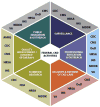Toward a more collaborative federal response to chronic kidney disease
- PMID: 20439097
- PMCID: PMC2875061
- DOI: 10.1053/j.ackd.2010.03.006
Toward a more collaborative federal response to chronic kidney disease
Abstract
Chronic kidney disease (CKD) is a significant public health problem in the United States. However, data from the United States Renal Data System and other sources suggest that care for people with CKD does not meet recommended standards. The Federal government has developed the infrastructure to promote population-based interventions which have reduced the burden of other chronic illnesses. An effective, coordinated response by Federal health agencies to the public health challenge of CKD could have a significant effect on the morbidity, mortality, and costs associated with CKD. In recent years, initiatives undertaken by three Federal agencies have made important advances in coordinating efforts. The Centers for Disease Control and Prevention has begun to develop public health infrastructure for monitoring the burden of CKD. The Centers for Medicare and Medicaid Services has, through the successful Fistula First Breakthrough Initiative (FFBI) and inclusion of CKD in the scope of work of Quality Improvement Organizations, promoted earlier diagnosis and treatment of CKD. The National Institute of Diabetes and Digestive and Kidney Diseases, through its National Kidney Disease Education Program, has reinvigorated and expanded the Kidney Interagency Coordinating Committee so that it is a robust vehicle to share information about activities, identify and disseminate promising practices and tools, and foster cross-agency collaboration. Collaboration among Federal health agencies has the potential to enhance efforts to reduce the burden of CKD.
Similar articles
-
Federal efforts to improve quality of care: the Quality Interagency Coordination Task Force (QuIC).Jt Comm J Qual Improv. 2001 Feb;27(2):93-100. doi: 10.1016/s1070-3241(01)27009-6. Jt Comm J Qual Improv. 2001. PMID: 11221014
-
The National Kidney Disease Education Program: improving understanding, detection, and management of CKD.Am J Kidney Dis. 2009 Mar;53(3 Suppl 3):S115-20. doi: 10.1053/j.ajkd.2008.05.038. Am J Kidney Dis. 2009. PMID: 19231755
-
The Kidney Disease Initiative and the Division of Diabetes Translation at the Centers for Disease Control and Prevention.Am J Kidney Dis. 2009 Mar;53(3 Suppl 3):S121-5. doi: 10.1053/j.ajkd.2008.06.037. Am J Kidney Dis. 2009. PMID: 19231756
-
CKD surveillance using administrative data: impact on the health care system.Am J Kidney Dis. 2009 Mar;53(3 Suppl 3):S27-36. doi: 10.1053/j.ajkd.2008.07.055. Am J Kidney Dis. 2009. PMID: 19231758 Review.
-
Realizing the Goals of the Advancing American Kidney Health Initiative: Toward a Better Future for Kidney Disease Research Funding.Adv Chronic Kidney Dis. 2022 Jan;29(1):76-82. doi: 10.1053/j.ackd.2022.01.005. Adv Chronic Kidney Dis. 2022. PMID: 35690408 Review.
Cited by
-
Charlson comorbidity index and all-cause mortality in patients with delayed hemodialysis initiation: a prospective cohort study.BMC Nephrol. 2025 Jul 11;26(1):376. doi: 10.1186/s12882-025-04197-x. BMC Nephrol. 2025. PMID: 40646499 Free PMC article.
-
Chronic kidney disease and the global public health agenda: an international consensus.Nat Rev Nephrol. 2024 Jul;20(7):473-485. doi: 10.1038/s41581-024-00820-6. Epub 2024 Apr 3. Nat Rev Nephrol. 2024. PMID: 38570631 Review.
-
Health related quality of life among haemodialysis and kidney transplant recipients from Nepal: a cross sectional study using WHOQOL-BREF.BMC Nephrol. 2020 Oct 12;21(1):433. doi: 10.1186/s12882-020-02085-0. BMC Nephrol. 2020. PMID: 33046010 Free PMC article.
-
Prevalence and variation of Chronic Kidney Disease in the Irish health system: initial findings from the National Kidney Disease Surveillance Programme.BMC Nephrol. 2014 Nov 25;15:185. doi: 10.1186/1471-2369-15-185. BMC Nephrol. 2014. PMID: 25425510 Free PMC article.
-
Study of Arteriovenous Fistula Cases in a Tertiary Care Hospital: A Descriptive Cross-sectional Study.JNMA J Nepal Med Assoc. 2020 May 30;58(225):324-327. doi: 10.31729/jnma.4957. JNMA J Nepal Med Assoc. 2020. PMID: 32538927 Free PMC article.
References
-
- U.S. Renal Data System. USRDS 2008 Annual Data Report: Atlas of Chronic Kidney Disease and End-Stage Renal Disease in the United States. Vol. 1. National Institutes of Health, National Institute of Diabetes and Digestive and Kidney Diseases; Bethesda, MD: 2008. p. 84. Fig.
-
- Giatras I, Lau J, Levey AS. Effect of angiotensin-converting enzyme inhibitors on the progression of nondiabetic renal disease: a meta-analysis of randomized trials. Angiotensin-Converting-Enzyme Inhibition and Progressive Renal Disease Study Group. Annals of Internal Medicine. 1997 Sep 1;127(5):337–45. - PubMed
-
- Jafar TH, Schmid CH, et al. Angiotensin-converting enzyme inhibitors and progression of nondiabetic renal disease. A meta-analysis of patient-level data. Annals of Internal Medicine. 2001 Jul 17;135(2):73–87. Erratum in: Annals of Internal Medicine. 2002 Aug 20;137(4):299. - PubMed
-
- Sarnak MJ, Greene T, et al. The effect of a lower target blood pressure on the progression of kidney disease: long-term follow-up of the Modification of Diet in Renal Disease study. Annals of Internal Medicine. 2005 Mr 1;142(5):342–51. - PubMed
MeSH terms
Grants and funding
LinkOut - more resources
Full Text Sources
Medical


